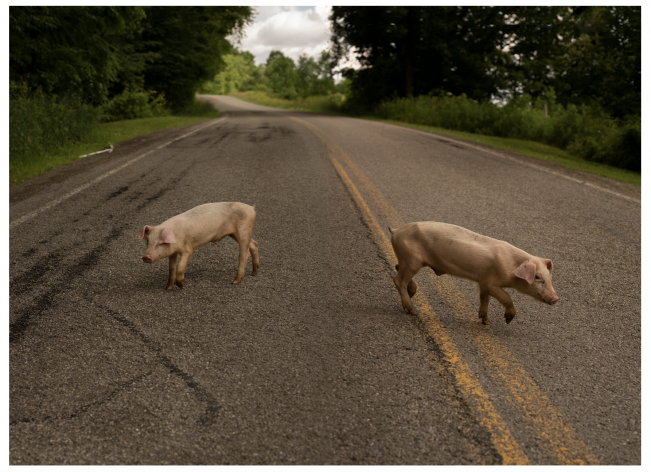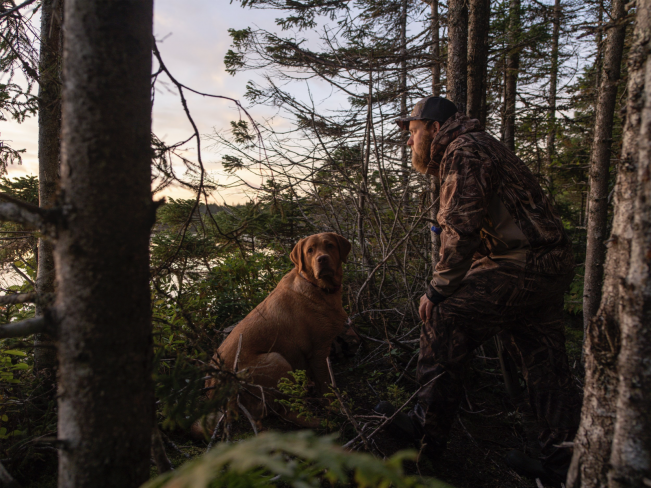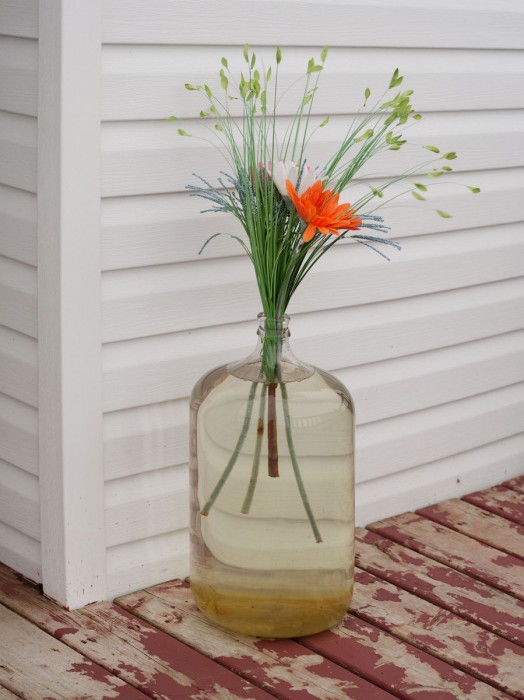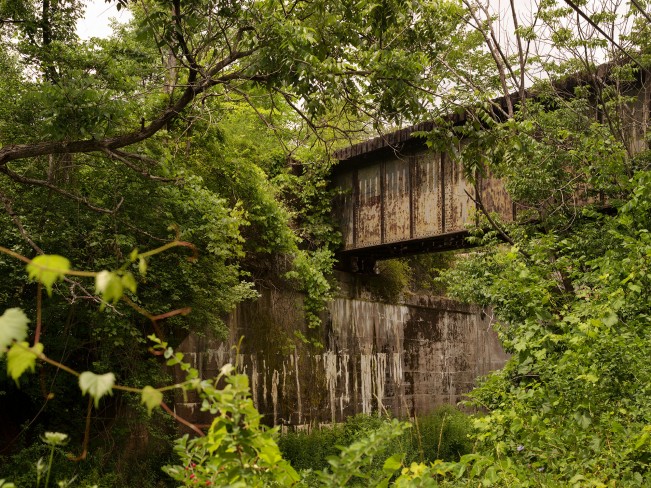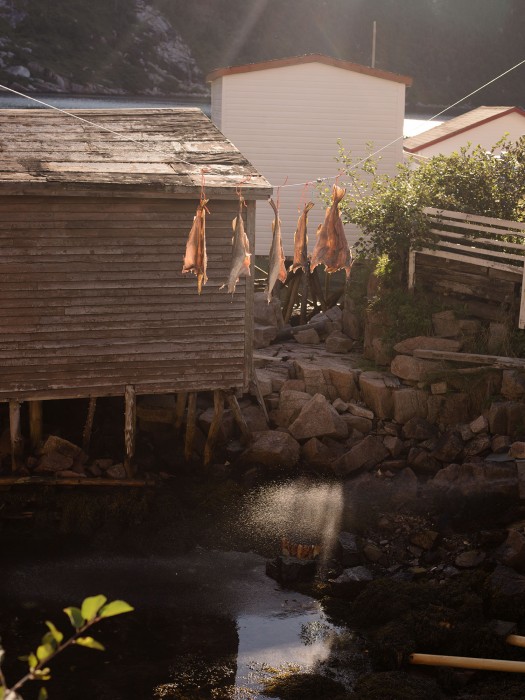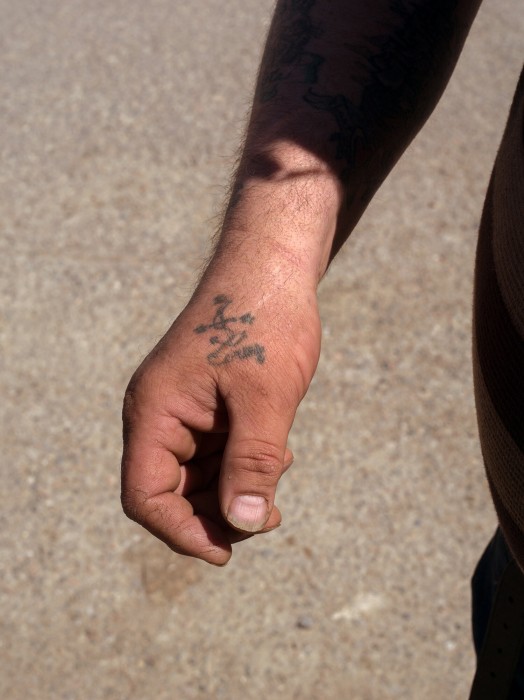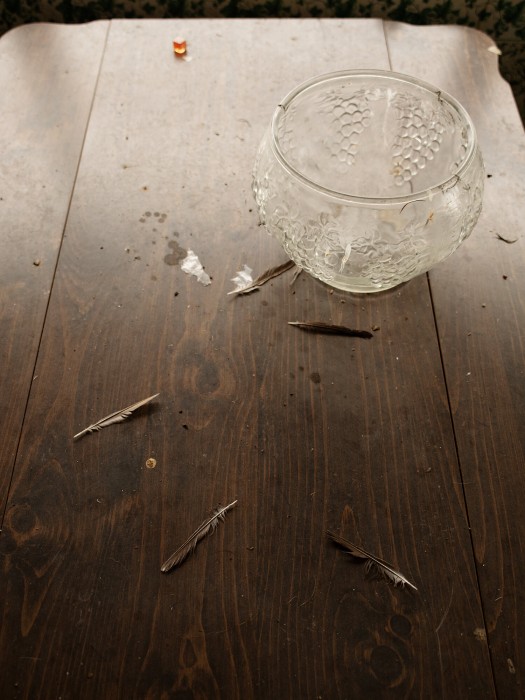Ryan Arthurs in Conversation with Douglas Breault
Ryan Arthurs is an artist and gallerist from Buffalo, NY who understands the potential for photographs to capture the sensitivity and enchantment found in portraiture and the landscape. His images require slow looking to reveal the element of peculiar magic found within pastoral and idealistic landscapes. The figures in his photographs often remain semi-anonymous, cloaked in shadow or fragmented in their framing, to offer an affectionate peek into a narrative truth activated by the physical environment. A consistent idea in all of Arthurs’s photographs is a depiction of near isolation. The images introduce a cinematic vastness, similar to the start of a film, that hints to how the plot may thicken as the timeline progresses.

©Ryan Arthurs, from the series “nothing of weeds”
His different bodies of work commonly translate the cycle of change, whether it be of the seasons or an element of death itself, adorned in a warmth of patient gratitude for life through contemplation of the landscape. Arthurs is consistently expanding upon his projects, spending years ritualistically nurturing a body of work. His latest body of work, nothing of weeds, began at the start of the pandemic and rattles with the sense of strain derived from the unknown. There is a hushed tone to his observations. The images feel equal parts optimistic and accidental, in search of utopia against the backdrop of rural western New York. In some sense, utopia would feel as if the individual is sufficiently sustained in isolation amongst the land instead of dependent upon technology.
Arthurs says about the series, “Weeds and flora within this series are a doubled metaphor for the preponderance of right-wing ideologies in rural communities, while speaking to the struggles of finding and maintaining presence as a queer person. These narratives emerge and struggle against one another throughout the series, adding tension to otherwise bucolic landscapes”.
The entanglement of political ideologies and identities in the rural corners of the country inevitably overlap, and Arthurs explores how a multitude of histories struggle against one another. Arthurs is continually questioning what queerness can be in forgotten and contained spaces, like the wilderness or the American military, by capturing and recontextualizing historical photographs. Often photographers use the camera as a justification to traverse the landscape in solitude, climbing through abandoned buildings or wandering unknown pathways. Arthurs extends that adventurer curiosity by meticulously framing his compositions to position you to gaze into the distance that feels like it has a foot in two different worlds. The immense details and textures within his images hold your attention to the stillness within the frame, offering a tender scene to consider what was once there and what could hope to exist there in the future.
How has the covid pandemic affected how you approached making work?
I was working on nothing of weeds during the very beginning of Covid, and there was that like the first month where people weren’t going anywhere. And then after a bit, you were like, oh, it’s, it’s actually okay if I’m driving around or I’m going to the gas pump. That is why those pictures are pretty not populated, at least at the beginning of the covid pandemic. Like there’s a picture of all those bones on a plate, and that was like, we bought a turkey because we needed the most leftovers to do the fewest trips to the store. So we bought a Turkey, we made the turkey, I cut it, then I boiled the bones and made a stew. So there’s like something that it feels like the beginning of covid in some of these pictures to me as well, even if they don’t look like Covid pictures.
These photos were made during the preceding presidential election, its aftermath, and through the aggregate of a global pandemic. They contain moments of anxiety and loss, but also moments of solace and hope. The work approaches rural space with tenderness and generosity, while fields of flowers, orchards, structures covered with tangled plants soften the edges of these rusty, charred, derelict structures. The work within this series aims to imbue these landscapes with a queerness and vibrancy not contingent upon the weeds, but negotiated through and by their growth.
This region often doesn’t really feel like they have a kind of queer existence, but it also feels really verdant with possibilities for another type of living, like some sort of kind of queer liberation in these types of forgotten spaces. “Nothing of weeds” is kind of this double metaphor of like, what is a weed? Is the weed the Trumpy thing that’s kind of growing out and is kind of metastasizing and taking over like all the fuck Biden signs that you see out in the country? Or are the weeds the things that aren’t nourished and let grow this kind of sense of queer existence of like, people being able to live their own lives despite the fact that they’re not given the same kind of like nurturing.
Where are the photographs in the series Strata taken?
Since 2015 I have been making photographs between Nova Scotia, Newfoundland, and Scotland. These islands are situated between worlds, both geographically and metaphorically. They’ve come to embody the old and the new, spaces where time collapses, where past and present collide. For generations, families have survived on these rocky shores, living between the timeless beauty of the landscape and the hardship it poses.
In this body of ongoing work, I attempt to summarize a multitude of histories, to string together a new narrative through visual elements. The work contains ideas about immigration from Europe to the New World of Atlantic Canada. It imagines challenges of a transatlantic journey, hopes of a better life, free of famine and persecution. It represents months-long oceanic crossing, fear of a new landscape, homesteading to survive the biting Canadian winter.
Ryan Arthurs is a visual artist living in Buffalo, New York. He received his M.F.A. in Photography from Massachusetts College of Art and Design and holds a B.F.A. in Studio Art from Carleton College. Ryan was a visiting professor at Carleton College, and was a photography teaching assistant at Harvard University. He was a printmaking Artist-In-Residence at Anderson Ranch Arts Center in Snowmass Village, Colorado and The Bothy Project, Isle of Eigg in Scotland.
Arthurs’ work has been exhibited widely, including “The National: Best Contemporary Photography” at the Fort Wayne Museum of Art, Indiana. His solo exhibitions credits include Carleton College and Room 68 in Provincetown, Massachusetts. His work was selected by The Magenta Foundation Flash Forward Top 100 in 2018. In 2017 he was shortlisted for the Oseroff Memorial Purchase Prize administered by CEPA Gallery, and in 2015 was nominated for the Louis Comfort Tiffany Foundation Artist Award.
In 2020 Arthurs founded Rivalry Projects and serves as Director and Curator. Rivalry is founded on his competing motivations as an artist and curator to create an arts space that can function as both a site of exhibition and production of contemporary art. Rivalry exhibits emerging, mid-career and underrepresented artists working in all media, but with an emphasis toward contemporary photography.
Arthurs is also a founding member of Houseboat Press, a photography publishing company that has exhibited at both national and international art book fairs including; OFFPRINT Paris, the LA Art Book Fair, Aperture Foundation New York, and the Yale Museum of Art, New Haven.
Follow Ryan Arthurs on Instagram: ryanarthursphoto
Douglas Breault is an interdisciplinary artist who overlaps elements of photography, painting, sculpture, and video to merge spaces both real and imagined. His work has been collected, published, and exhibited nationally and internationally, including at the Museum of Fine Arts Boston, the Czong Institute for Contemporary Art (South Korea), Space Place Gallery (Russia), the Bristol Art Museum, the Rochester Museum of Fine Arts, Amos Eno Gallery, and VSOP Projects. Breault has been an artist in residence at MassMoca and AS220 and was awarded the Montague Travel Grant to study in London and Paris in 2017. Douglas is a professor of art at Babson College and Bridgewater State University, and he has been a guest critic at MassArt, Wellesley College, Kansas City Art Institute, and the Slade College of Art, among others. Douglas is the Exhibitions Director at Gallery 263 in Cambridge, MA. He received his MFA from the School of the Museum of Fine Arts at Tufts University and a BA in Studio Art from Bridgewater State University, and he currently divides his time between Boston, MA, and Providence, RI.
Follow Douglas Breault on Instagram: @dug_bro
Posts on Lenscratch may not be reproduced without the permission of the Lenscratch staff and the photographer.
Recommended
-
Tara Sellios: Ask Now the BeastsApril 6th, 2024
-
ALEXIS MARTINO: The Collapsing Panorama April 4th, 2024
-
Emilio Rojas: On Gloria Anzaldúa’s Borderlands: The New MestizaMarch 30th, 2024
-
Artists of Türkiye: Eren SulamaciMarch 27th, 2024
-
Love and Loss in the Cosmos: Valeria Sestua In Conversation with Vicente IsaíasMarch 19th, 2024


